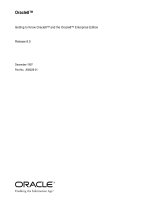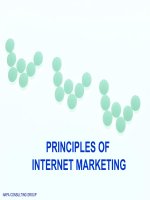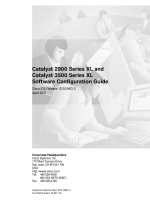Tài liệu LESSON 12: INTERNET LEGALITIES AND ETHICS pdf
Bạn đang xem bản rút gọn của tài liệu. Xem và tải ngay bản đầy đủ của tài liệu tại đây (289.51 KB, 14 trang )
LESSON 12
INTERNET LEGALITIES AND
ETHICS
“License for Use” Information
The following lessons and workbooks are open and publicly available under the following
terms and conditions of ISECOM:
All works in the Hacker Highschool project are provided for non-commercial use with
elementary school students, junior high school students, and high school students whether in a
public institution, private institution, or a part of home-schooling. These materials may not be
reproduced for sale in any form. The provision of any class, course, training, or camp with
these materials for which a fee is charged is expressly forbidden without a license including
college classes, university classes, trade-school classes, summer or computer camps, and
similar. To purchase a license, visit the LICENSE section of the Hacker Highschool web page at
www.hackerhighschool.org/license.
The HHS Project is a learning tool and as with any learning tool, the instruction is the influence
of the instructor and not the tool. ISECOM cannot accept responsibility for how any
information herein is applied or abused.
The HHS Project is an open community effort and if you find value in this project, we do ask
you support us through the purchase of a license, a donation, or sponsorship.
All works copyright ISECOM, 2004.
2
LESSON 12 – INTERNET LEGALITIES AND ETHICS
Table of Contents
“License for Use” Information............................................................................................................... 2
Contributors..............................................................................................................................................4
12.1. Introduction.....................................................................................................................................5
12.2. Foreign crimes versus local rights ................................................................................................ 5
12.3. Crimes related to the TICs ............................................................................................................7
12.4. Prevention of Crimes and Technologies of double use ............................................................8
12.4.1. The global systems of monitoring: concept "COMINT" ......................................................8
12.4.2. "ECHELON" System...................................................................................................................9
12.4.3. The "CARNIVORE" system........................................................................................................9
12.5. Ethical Hacking.............................................................................................................................11
12.6. The 10 most common internet frauds........................................................................................12
12.7. Recommended Reading............................................................................................................14
3
LESSON 12 – INTERNET LEGALITIES AND ETHICS
Contributors
Francisco de Quinto, Piqué Abogados Asociados
Jordi Saldaña, Piqué Abogados Asociados
Jaume Abella, Enginyeria La Salle (URL) – ISECOM
Marta Barceló, ISECOM
Kim Truett, ISECOM
Pete Herzog, ISECOM
4
LESSON 12 – INTERNET LEGALITIES AND ETHICS
12.1. Introduction
New technologies, while building a new paradigm that invades every human activity, also
influence the dark side of these activities: criminal behavior of individuals and of organized
groups.
For this reason, we have reserved the last lesson of HHS to analyze some aspects related to
Legality and Ethics, analyzing several behaviors that could end in crimes and the
consequences of these crimes.
12.2. Foreign crimes versus local rights
As noted above, the introduction of new technologies can result in the creation of new dark
sides of activities: criminal behavior of individuals or organized groups. There are two main
characteristics through which Information Technology and Communications (TIC’s) are
related to crime:
1. Technologies can give the possibility of renewing traditional ways of breaking the law.
These are illegal activities which traditionally appear in the penal codes, but are now
being attempted in new ways. Examples include money laundering and illegal types
of pornography.
2. In addition, because of their own innovation, TIC’s are resulting in the appearance of
new types of criminal activities, and because of their nature, these new crimes are in
the process of being added to the legislation of several countries. Examples include
the distribution of spam and virus attacks.
Another characteristic of the TICs which must be emphasized is their territorial displacement,
which affects the general surroundings but without any doubt affects other countries as well.
Previously, areas of 'law' always had a clear territory regarding the judicial authority judging
(COMPETENT JURISDICTION) and also regarding the law to be applied in the judging
(APPLICABLE LAW). Both concepts are still noticeably geographic.
In summary, we can say that the TICs are global and essentially multi-border, while the law
and the courts are limited to a specific state or territory. In addition, this disorientation is even
more confusing than it initially appears. Although we are not aware of it, a bidirectional online
communication between a user in Barcelona and a Web site hosted in an ISP in California
can pass through more than 10 ISPs, hosted in a variety of remote points around the world.
Facing this diversity of addresses and nationalities, it becomes necessary to ask What laws of
which country will be applied in case of litigation? Which of the possible countries will be the
suitable court to adjudicate the case?
The relatively recent European Council's agreement on cyber-crime was signed in November
2001 in Budapest by almost 30 countries, including the 15 partners of the European Union, the
United States, Canada, Japan and South Africa. This agreement intends to restore the
TERRITORIAL PRINCIPLE to define competent jurisdiction. The signing of this agreement is the
culmination of four years of work that have resulted in a document containing 48 articles that
are organized into four categories:
1. Infractions against confidentiality
2. Falsification and computer science fraud
3. Infractions relative to contents
4. Violations of intellectual property
5
LESSON 12 – INTERNET LEGALITIES AND ETHICS









